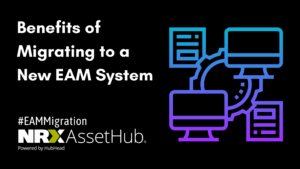Migrating to a new EAM system can be a lengthy project. Even though it may seem overwhelming, many asset-intensive companies get to where an EAM migration becomes necessary. An EAM migration can have many benefits for the efficiency of your maintenance processes and your ROI. However, certain best practices for EAM migrations help ensure you get the most out of your new system.

Set Your EAM Migration as a Separate Project
Many EAM migrations fail because companies do not plan their migration as a separate project. When an EAM migration is scheduled as a separate project, maintenance teams can conduct the migration in a systemized manner. As well, setting your EAM migration as a separate project allows you to establish timelines and assign specific tasks to people in your team, which helps your migration project stay on track.
Drop Bad Habits
An EAM migration is a significant transitionary period for an asset-intensive company. Your current EAM or CMMS system goes through various changes, so this is an ideal time for companies to re-strategize their maintenance procedures. Revisit your business goals and assess whether your asset performance is aligned with your goals. For example, you can consider the current state of your master data and whether corporate standards are being met. You can address bad habits, such as inaccurate maintenance and asset master data, missing information, outdated machinery, or gaps in your maintenance processes. With the right tools, you can eliminate these bad habits and extract maximum value from your new EAM system.
Invest in the Right Technology and People for Your Migration
Investing in the right technology and the right people for your EAM migration can help you achieve the desired benefits of your new EAM system. There is always a risk of missing important data during the data migration process. Choosing a migration solution specifically for ensuring smooth and efficient EAM migrations and building to migrate asset and maintenance master data can help avoid gaps and inaccuracies in your master data.
Implement Proper Training
A big part of extracting the maximum value of your new EAM system is ensuring your maintenance technicians have adequate employee training. It is critical that maintenance and reliability professionals know how to effectively use your EAM system to meet business goals and improve asset performance. Without appropriate training, your employees may be frustrated, confused, and morale will decrease. This can be evident in productivity and may prevent your company from reaching performance goals.
Improve Data Accuracy
When conducting an EAM migration, it is critical that your asset and maintenance master data is reviewed before it is loaded into your new EAM system. Completing a data cleanse or data quality improvement project before you load your data into your new EAM system is a vital step to ensuring that the data you migrate into your new system is reliable and accurate so that your new EAM supports efficient maintenance operations.

Get the Most out of Your New System
It is not easy to migrate all your data to a new system. It takes a significant amount of time, effort, and strategy to migrate to a new system without losing important information.
While a new EAM system can have many benefits for your company’s maintenance procedures and ROI, implementing these best practices helps ensure you can reap all the value of your new system.
NRX AssetHub, powered by HubHead Corp., provides asset-intensive businesses with world-class software for visualizing, building, editing, organizing, governing, and sustaining high-quality asset and maintenance data for their EAM and CMMS systems. If you would like to learn more about how our solutions can help you with your EAM migration, book a demo, and our team would be happy to help you!
Benefits of Migrating to a New EAM System
How Do you Know if your EAM Migration was Successful?
Your EAM Migration Failed, Now What?
Share this article




